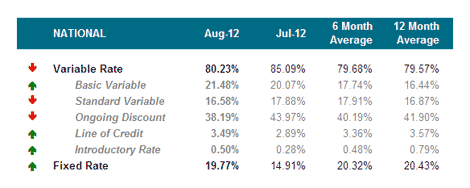Lower rates and conservative mindset drive fixed-rate demand to one in five home loans in August: Mortgage Choice
Mortgage Choice has attributed a marked increase in the popularity of fixed-rate home loans in August to more attractive reduced rate offerings and a penchant for borrowers to be conservative in their choice of home loans.
Fixed-rate home loans accounted for nearly one in five home loans arranged by Mortgage Choice mortgage brokers in August, a five percentage point increase from July.

At the same time as fixed-rate demand increased ongoing discount rate loan demand fell for the first time in five months, from 44% to 38%.
Ongoing discount rate loan loans are those where the rate is discounted over the entire loan term.
Company spokesperson Belinda Williamson called this a surprising result and the first time in five months that demand for this loan type has diminished.
The other noticeable tend in the August data was that the popularity of no-frills, basic variable-rate loans reached a 14-month high of 21% of all new loans.
Williamson says lenders have been tweaking their fixed-rate loans, making the price of such loans more competitive in some cases when compared with variable rates.
“Looking at Mortgage Choice’s lender panel, the average three-year fixed rate, the most popular fixed rate term, currently sits at just over 6%. This is about 0.30 percentage points lower than the average basic variable rate home loan.”
According to research by Property Observer, the current lowest rate available on a three-year fixed-rate mortgage is 5.44% offered by lender My Mortgage Freedom.
The lowest variable rate offering is a 5.62% refinance loan from UBank, part of NAB.
“The upward trend in fixed-rate loan demand was evident in all states except Western Australia, where fixed-rate demand fell by one percentage point," says Williamson.
She says the data reflects the prevailing conservative attitude of Australians.
“Many more mortgage holders are locking in the interest rate on part or all of their loan so they can structure their repayments and take better control over their finances,” she says.
“It is obvious that concerns about our domestic economy, rising utility bills and other living cost hikes along with predictions of fewer rate cuts taking place this year are having an effect on the purchasing decisions of Australians. Home loan choices are no exception.”